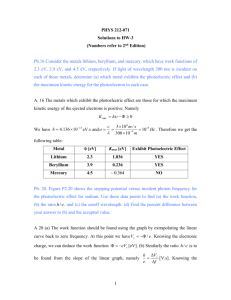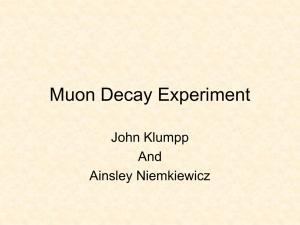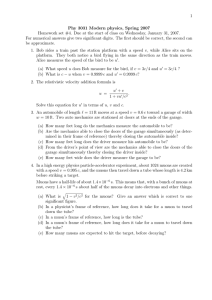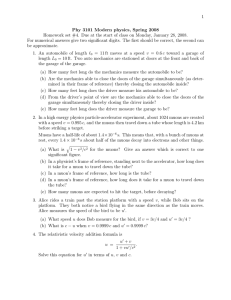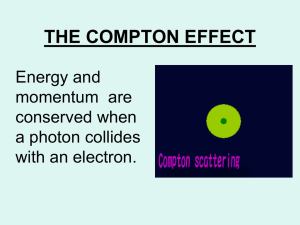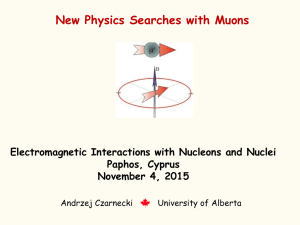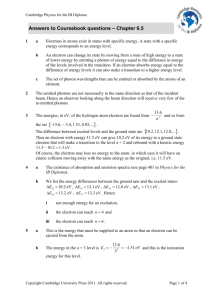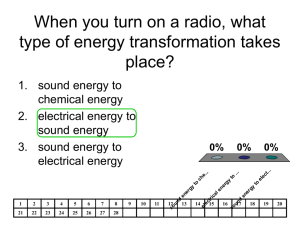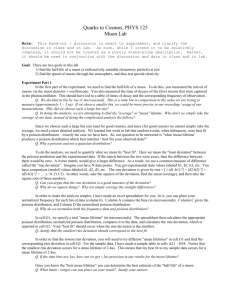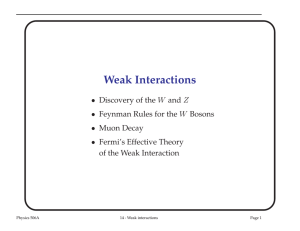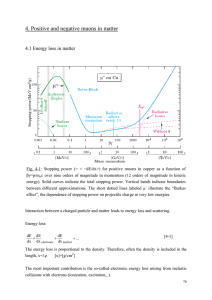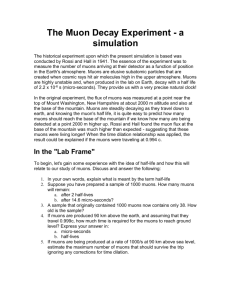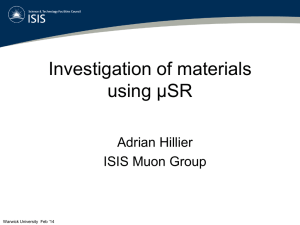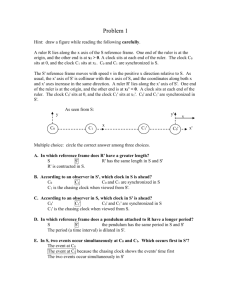doc - King Fahd University of Petroleum and Minerals
advertisement
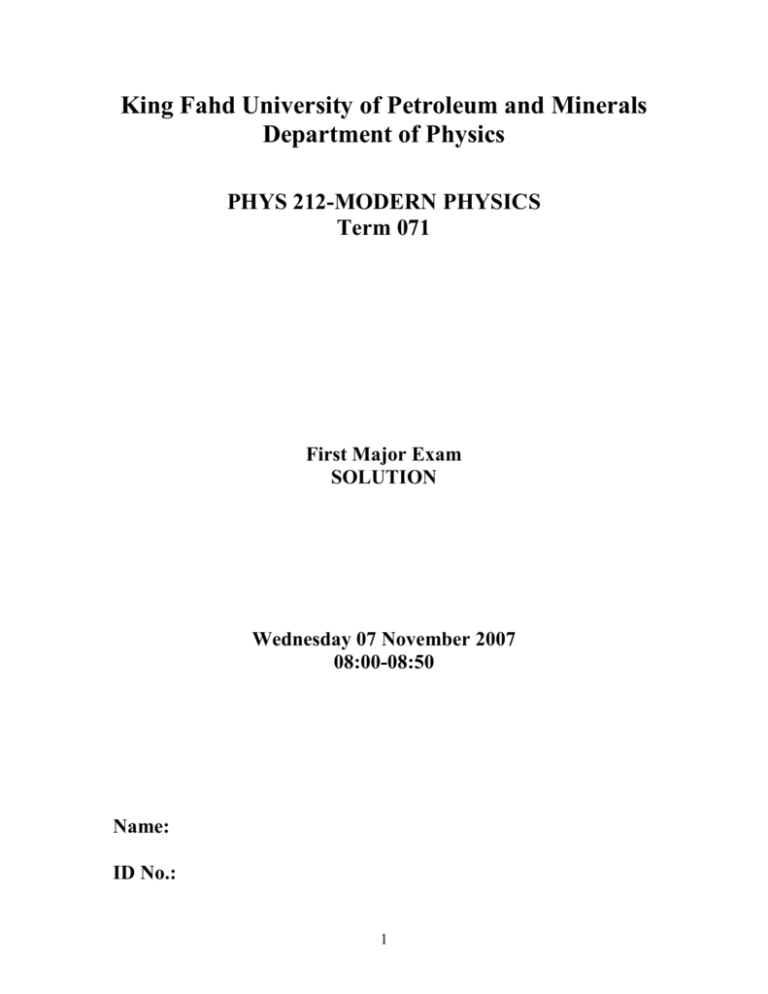
King Fahd University of Petroleum and Minerals Department of Physics PHYS 212-MODERN PHYSICS Term 071 First Major Exam SOLUTION Wednesday 07 November 2007 08:00-08:50 Name: ID No.: 1 Q1. The muon is an unstable particle that spontaneously decays into an electron and two neutrinos. If the number of muons at t 0 is N 0 , the number at time t is given by N N 0 e t / , where is the mean lifetime, equal to 2.2 s . Suppose the muons move at a speed of 0.95 c and there are 5.0 10 4 muons at t 0 . (a) What is the observed lifetime of the muons? (b) How many muons remain after traveling a distance of 3.0 km ? A1. In the rest frame of the muon we have N N 0 e t respect to which the muon is moving we have N N 0 e v2 v 0.95c , and 1 2 c N N0e d v 5 10 e 4 1 2 . In a reference frame with t , where t d , , v 3.2 ; therefore 3000 3.20.953108 2.210 6 11,210 muons. Q2. A radium isotope decays to a radon isotope helium nucleus) according to the decay scheme 222Rn 226Ra by emitting an particle (a 222Rn + 4He. The masses of the atoms are 226.0254 (Ra), 222.0175 (Rn), and 4.0026 (He). How much energy is released as a result of this decay? A2. In the decay 226 Ra 222Rn 4He the conservation of energy in the rest frame of the 226 Ra nucleus can be written as M Ra c 2 M Rn c 2 K Rn M He K He where K is the kinetic energy. Therefore, the energy released is K Rn K He ( M Ra M Rn M He )c 2 (226.0254u 222.0175u 4.0026u )c 2 5 10 3 uc 2 MeV We also know that 1u 931.5 2 . Therefore the energy released in the decay is c 5 10 3 931.5 4.94MeV 2 Q3. Photons of wavelength 450 nm are incident on a metal. The most energetic electrons ejected from the metal are bent into a circular arc of radius 20 cm by a magnetic field whose strength is equal to 2.0 10 5 T. What is the work function of the metal? A3. We have p qBR pc qBRc 1.6 10 19 C 2.0 10 5 T 0.2m 3 108 m / s 1.2 10 3 eV 1.2keV. We also have E 2 ( pc) 2 (mc 2 ) 2 (mc 2 K ) 2 K ( pc) 2 (mc 2 ) 2 mc 2 Since mc 2 511keV , we get K 1.41eV From the equation K h h K hc K, we get 1240eVnm 1.41nm 2.76eV 450nm Q4. X-rays of wavelength 0.200 nm are scattered from a block of carbon. If the scattered radiation is detected at 90o to the incident beam, find (a) the Compton shift and (b) the kinetic energy imparted to the electron. A5. We have 0.00243nm(1 cos ) 0.00243nm for 90 0 . Therefore the wavelength of the scattered photon is 0.200nm 0.00243nm 0.20243nm The kinetic energy of the electron is 1 1 K h h hc( ) 74.5eV 3 Q5. (a) Calculate the longest and shortest wavelengths of the Balmer series. (b) Determine the photon energies (in eV) corresponding to these wavelengths. A5. (a) We have the Rydberg formula 1 1 R 2 2 , n f ni 1 Where R 1.097 10 7 m 1 is the Rydberg constant. For the Balmer series n f 2 . The longest wavelength corresponds to ni 3 , and the shortest wavelength corresponds to ni . Substituting for these in the above formula we get longest 656.3nm and shortest 364.6nm . (b) The energies can be found by using the relation E h hc . After substitution for the wavelengths found in (a) we get Elongest 1.9eV and E shortest 3.4eV . Q6. Explain why Emission spectra contain more spectral lines than absorption spectra for the same element. A6. In emission spectra the higher energy electron can cascade down to many lower energy orbits therefore giving rise to many emission spectral lines. In absorption spectra, however, the lower energy electron can move up to only ONE higher energy orbit thereby creating fewer spectral lines. Q7. What is the single most important experimental observation supporting the explanation of the photoelectric effect in terms of the particle nature of light. A7. The fact that the stopping voltage (maximum kinetic energy of photoelectrons) does not depend on the intensity of the light but depends ONLY on its frequency. 4 Q8. Explain why we believe that there are tiny nuclei inside atoms. A8. Because of the large number of alpha particles scattered at large angles in Rutherford scattering. Q9. What is the postulate due to Bohr that is necessary to derive the discreteness of atomic radii? A9. L n , where L is the angular momentum of the electron moving around the nucleus. Q10. Explain why it is necessary to use Lorentz transformations instead of Galilean transformations when we want to relate events in a moving reference frame to events in another, fixed reference frame? A10. Because they are the only transformations that leave the speed of light constant (as observed experimentally) between these reference frames. 5
